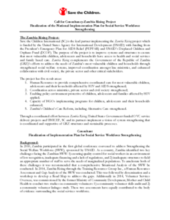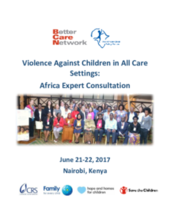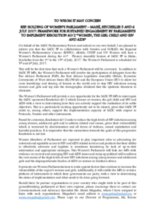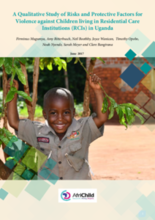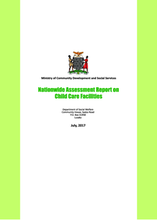Displaying 831 - 840 of 1609
CRS is recruiting for a 4Children Mozambique Program Manager (PM), who will provide overall project management and technical leadership to 4Children's project in Mozambique.
Save the Children is recruiting for a consultant to review and finalize Zambia's National Implementation Plan to strengthen the Social Service Workforce.
This study aimed to test the effectiveness of life skills education (LSE) and psychoeducation in the reduction of Youth Self Report (YSR) scores on institutionalized children in Kenya, using structured activities supported by trained facilitators.
On 21-22 June 2017, the African Child Policy Forum and Better Care Network - with the support of Catholic Relief Services, Family for Every Child, Hope and Homes for Children and Save the Children - convened 40 leaders representing child rights bodies, regional economic communities, national governments and civil society in Nairobi, Kenya for the Africa Expert Consultation: Violence Against Children in All Care Settings.
This news article provides a report of the June 2017 Africa Expert Consultation on Violence against Children in All Care Settings, held in Nairobi, Kenya.
In this video, Kate van Doore describes the process of 'paper orphaning,' a term coined to characterize how children are recruited and trafficked into orphanages to gain profits through international funding and orphanage tourism.
SADC Parliamentary Forum, in collaboration with Sweden and NORAD; the Regional Women’s Parliamentary Caucus (RWPC); ARASA; UNDP and UN Women, will host a Plenary Assembly Session of SADC PF from July 3 to 15, 2017 in Mahe, Seychelles. The Women’s Parliament will be scheduled for July 5th and 6th, 2017.
This qualitative study of risks and protective factors for violence against children living in
Residential Care Institutions (RCIs) for children is part of the wider qualitative study on violence
against children in Uganda. The study complements the national wellness survey that sought to
measure the prevalence of violence against children in household, schools and the community from
a quantitative perspective
This report is based on findings the Nationwide Assessment of all Child Care Facilities (CCFs) in Zambia, which aimed to gather evidence for the purpose of updating baseline information pertaining to the condition of all Child Care Facilities (CCFs) in Zambia; in line with the Minimum Standards of Care for Child Care Facilities (MSC), United Nations Convention on the Rights of the Child (UNCRC) as well as the UN Guidelines for the Alternative Care of Children.
Over 3000 children from orphanages in Rwanda have been reintegrated into family-based care since 2012, reports an official from the National Children's Council.

